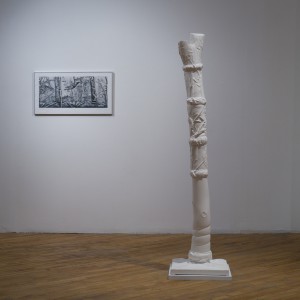
Inkjet print. Peripheral photograph by Michael Zajac of a porcelain tree form by Grace Nickel.
Grace Nickel, Fabricated Tree Form No. 1, 2012
Porcelain
Grace Nickel’s Artist Statement
I grew up in southern Manitoba and moved to the city of Winnipeg when I turned eighteen. My family home was situated near Plum Coulee, the flatest part of Manitoba, where trees were rare and those that did exist were planted in a purely calculated and practical manner. I have never taken trees for granted. Now, my porcelain trees inhabit a metaphorical space situated between urban and rural existence, the fabricated and the naturally occurring. Trees are a welcome relief in our ever-sprawling and invasive urban landscape. They provide natural beauty and protection, and we go to great lengths to preserve them. We also cut them down – once stripped of their bark, planed and standardized into uniform building blocks, they serve to create shelter.
But trees are indifferent; they tower above us ominously, prone to disease, parasites, and old age, frequently felled and destroyed by design or natural disasters. Yet we bestow a symbolic significance on trees – they play a commemorative role, often planted to acknowledge a momentous occasion, be it historic, celebratory or mournful. Through this act, they gain special status. In the studio, I reflect on this culture versus nature dialectic, creating a series of sculptural tree forms that either permanently or temporarily inhabit an environment and mark a spot.
On a technical level, some of my current interests include fabric-formed mould making and non-orthogonal digital photography of my works. The stitching and stretching of fabric to form models for plaster moulds harkens back to my childhood days as a meticulous and award-winning sewing sampler maker. But the fabric processes also correspond to the stitched images that are being created by having my 3-D tree forms photographed in the round and stretched flat, resulting in strange, surreal landscapes. Although 2-D work is often a precursor to 3-D creations, I am fascinated by turning that tradition around and beginning with the 3-D as a means to achieving a 2-D end. I am grateful for the collaboration, ingenuity, and skill of Michael Zajac in producing these non-orthogonal images of my porcelain trees. I also want to acknowledge the expertise and generous assistance of Ronnie Araya, architect and research assistant at CAST (Centre for Architectural Structures and Technology) at the University of Manitoba.